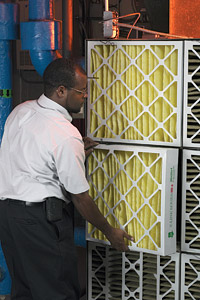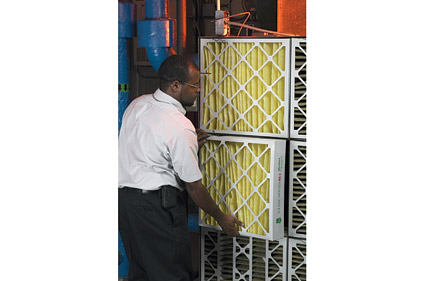
|
| Contractors may need more information in order to evaluate how well a lower-MERV filter removes smaller particles. (Photo courtesey of Kimberly-Clark Corp.) |
Air filters perform an important function in commercial and institutional facilities. Because indoor air is typically two to five times more polluted than outdoor air, air filters are needed to remove respirable particles such as microorganisms, dust, and allergens from the breathing air.
In fact, filters provide the primary defense for building occupants and HVAC equipment against indoor air pollutants. The extent to which filters remove airborne particles is referred to as filtration efficiency.
When it comes to evaluating filtration efficiency, people tend to look at the MERV rating. A Minimum Efficiency Reporting Value is assigned to filters based on their minimum fractional particle size efficiency, as determined under ASHRAE Standard 52.2. But more information may be needed to evaluate how well a lower-MERV filter removes smaller particles.
While MERV does provide a simple basis for choosing a filter, in order to better understand its in-use performance, we also need to understand some basics about the type of media used in each filter.
In addition to choosing a MERV rating level, it’s important to consider the media type. For example, two similar filters of the same MERV rating (one using mechanical-only media and the other using electromechanical media) can have different filtration efficiencies and initial pressure drops. To conduct a more thorough filter selection review, it’s important to request and review each filter’s ASHRAE (American Society of Heating, Refrigerating, and Air-Conditioning Engineers) 52.2 test report.
ASHRAE 52.2 and IAQ
The ASHRAE 52.2 test provides the efficiency of the filter over three particle size ranges:
• E1 (very fine particles in the 0.3- to 1.0-micrometer range);
• E2 (fine particles in the 1.0- to 3.0-micrometer range); and
• E3 (coarse particles in the 3.0- to 10.0-micrometer range).
The E1, E2, and E3 ASHRAE 52.2 test values for a given filter provide a more complete picture of that filter’s performance over the three particle size ranges. They also provide additional information such as initial pressure drop, which can impact energy usage during the filter’s life.
In fact, under the ASHRAE 52.2 standard, there is no minimum requirement threshold for E1 particulate capture below a MERV 13 rating. Therefore, when specifying filters, ask the filter supplier for the ASHRAE 52.2 test report data. Filters that use mechanical media solely may only provide MERV data.
E1 and E2 Importance
High E1 and E2 efficiencies are critical to providing good IAQ. Most of the respirable dust and particles people breathe into their lungs are 3 micrometers and smaller. Lung-damaging dust, for example, can be as small as 0.5 micrometers, and some bacteria can be as small as 0.3 micrometers. It has been estimated that 50 percent of all illnesses and 27 percent of all respiratory illnesses are attributable to poor IAQ.
The impact of poor IAQ is staggering. Some estimates place the cost of poor IAQ to the United States' economy at $168 billion. Part of that cost relates to direct medical care, while some of it can be traced to reduced productivity due to “presenteeism” (when people go to work or school even when they are sick) and absenteeism.
It’s estimated that U.S. adults miss 14.5 million work days every year because of poor IAQ; presenteeism is thought to be up to 7.5 times more costly than illness-related absenteeism.
When ASHRAE published its updated Standard 52.2 in 2007, it included an appendix not found in the previous standard — Appendix J: Optional Method of Conditioning a Filter Using Fine KCL Particles. These results should not be confused with the filter’s E1, E2, and E3 Fine Particle Efficiency as a way to measure filter performance.
Mechano-Electret Media
With filters that combine mechanical and electret efficiency, the mechanical efficiency provides for sustained filtration efficiency and the electret charge increases initial efficiency. It’s particularly useful in increasing capture efficiency for E1 submicron particles because, while submicron particles are much smaller than the void spaces present in most commercial electret media, the electrostatic forces within the media structure allow those particles to be removed with high efficiency.
Filters with mechano-electret media also typically deliver lower airflow resistance, which translates to reduced energy consumption and cost.
Additional Factors
In addition to the performance factors measured under the ASHRAE 52.2 test standard, consider these variables when selecting a filter:
• Energy efficiency — How the filter’s resistance to airflow affects the energy consumed by the HVAC system. Energy expenditures can account for about 81 percent of the annual operating costs of an air filtration system.
• Moisture resistance and temperature limitations — How high humidity/moisture and temperature affect the filter.
• Sustainability — Consider the entire product lifecycle, from raw material sourcing to manufacturing, packaging to transport, and design and usage to final disposal.
In general, it’s important to look beyond a filter’s MERV rating and at the Fine Particle Efficiency rating as a true measure of its filtration efficiency.
Publication date: 11/21/2011


Report Abusive Comment